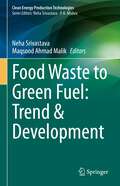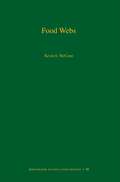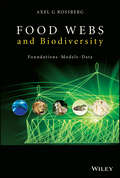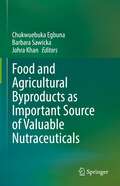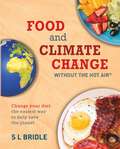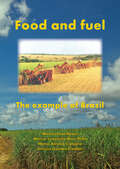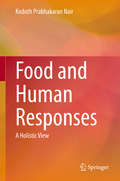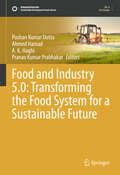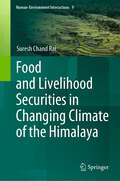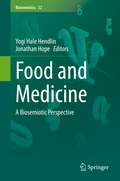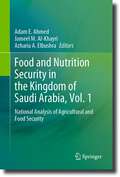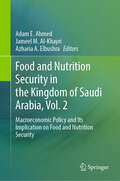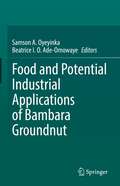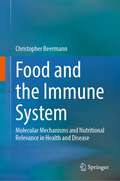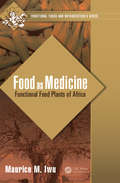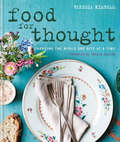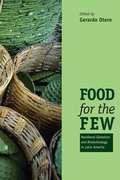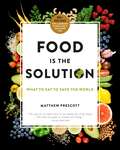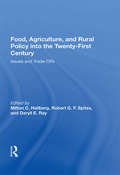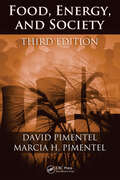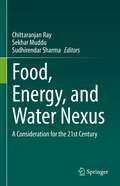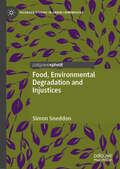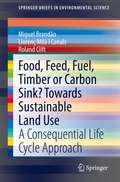- Table View
- List View
Food Waste to Green Fuel: Trend & Development (Clean Energy Production Technologies)
by Neha Srivastava Maqsood Ahmad MalikThis edited book covers all the existing possibilities of using food waste as a potential, alternative and ‘ready to use’, feed stock for biofuels production. Moreover, it also presents all the sustainable and economically feasible biofuels option with their details strategies, mechanism, advantages, draw backs and future scope. It also explores in depth knowledge of food waste, and details the processing as well as opportunities to utilize it at for mass scale biofuels production. The practical feasibility and economic sustainability of biofuels production is still suffering with its cost intensity and lack of rigorous scientific strategies as well as inputs to explore it on further at upscale level. Low cost, carbon rich, economic and environmental friendly feedstock, may have strong possibilities to reduce the overall biofuels production cost and the book is based on this strategy. The book is of interest to academicians and researchers interested in industries related to biofuels production, food processing industries and industries related to waste valorization.
Food Webs (Monographs in Population Biology #50)
by Kevin S. McCannHuman impacts are dramatically altering our natural ecosystems but the exact repercussions on ecological sustainability and function remain unclear. As a result, food web theory has experienced a proliferation of research seeking to address these critical areas. Arguing that the various recent and classical food web theories can be looked at collectively and in a highly consistent and testable way, Food Webs synthesizes and reconciles modern and classical perspectives into a general unified theory. Kevin McCann brings together outcomes from population-, community-, and ecosystem-level approaches under the common currency of energy or material fluxes. He shows that these approaches--often studied in isolation--all have the same general implications in terms of population dynamic stability. Specifically, increased fluxes of energy or material tend to destabilize populations, communities, and whole ecosystems. With this understanding, stabilizing structures at different levels of the ecological hierarchy can be identified and any population-, community-, or ecosystem-level structures that mute energy or material flow also stabilize systems dynamics. McCann uses this powerful general framework to discuss the effects of human impact on the stability and sustainability of ecological systems, and he demonstrates that there is clear empirical evidence that the structures supporting ecological systems have been dangerously eroded. Uniting the latest research on food webs with classical theories, this book will be a standard source in the understanding of natural food web functions.
Food Webs and Biodiversity
by Axel G. RossbergFood webs have now been addressed in empirical and theoretical research for more than 50 years. Yet, even elementary foundational issues are still hotly debated. One difficulty is that a multitude of processes need to be taken into account to understand the patterns found empirically in the structure of food webs and communities. Food Webs and Biodiversity develops a fresh, comprehensive perspective on food webs. Mechanistic explanations for several known macroecological patterns are derived from a few fundamental concepts, which are quantitatively linked to field-observables. An argument is developed that food webs will often be the key to understanding patterns of biodiversity at community level. Key Features: Predicts generic characteristics of ecological communities in invasion-extirpation equilibrium.Generalizes the theory of competition to food webs with arbitrary topologies.Presents a new, testable quantitative theory for the mechanisms determining species richness in food webs, and other new results.Written by an internationally respected expert in the field. With global warming and other pressures on ecosystems rising, understanding and protecting biodiversity is a cause of international concern. This highly topical book will be of interest to a wide ranging audience, including not only graduate students and practitioners in community and conservation ecology but also the complex-systems research community as well as mathematicians and physicists interested in the theory of networks. "This is a comprehensive work outlining a large array of very novel and potentially game-changing ideas in food web ecology."Ken Haste Andersen, Technical University of Denmark "I believe that this will be a landmark book in community ecology ... it presents a well-established and consistent mathematical theory of food-webs. It is testable in many ways and the author finds remarkable agreements between predictions and reality."Géza Meszéna, Eötvös University, Budapest
Food and Agricultural Byproducts as Important Source of Valuable Nutraceuticals
by Chukwuebuka Egbuna Barbara Sawicka Johra KhanFood and agricultural by-products are leftovers or wastes from parts of foods, fruits, vegetables and animal sources which are obtained after processing. Agricultural by-products includes peels and rinds from citrus fruits, pineapple, mango, and banana. Other notable ones are pomace from apple, olive, red beet, and those from wine making. Also, whey from milk, straws, hulls, and brans from grains are among top agricultural by-products. These by-products often impact the environment and the social-economic sectors when they are disposed. But with the recent advances in biotechnology and scientific research, scientists have found usefulness in some of these byproducts as sources of valuable nutraceuticals, a term used to refer to chemical entities present in foods that has the propensity to impact health for disease prevention and treatment. This book entitled ‘Food and agricultural by-products as important source of valuable nutraceuticals’ presents detailed information about major agricultural byproducts that are rich in nutraceuticals. The nature and the type of nutraceuticals that they contains and their health promoting benefits were presented. The editors and chapter contributors are renowned experts from key institutions around the globe. This book will be useful to students, teachers, food chemists, nutritionists, nutritional biochemists, food biotechnologists among others. Key features Ø Highlights the health promotion benefits of nutraceuticals Ø Presents information on agrifood by-products as sources of nutraceuticals Ø Discusses functional nutraceuticals from peels, rinds, pomace, hull, bran etc
Food and Climate Change without the hot air: Change your diet: the easiest way to help save the planet (without the hot air #8)
by S L Bridle• 25% of greenhouse gas emissions come from food – how can we reduce this? • What effect does the food we eat have on the environment? • How will climate change affect the food we will eat in the future? • Can the choices we make as consumers reduce carbon emissions dramatically? Inspired by the author's former mentor David MacKay (Sustainable Energy Without the Hot Air), Food and Climate Change is a rigorously researched discussion of how food and climate change are intimately connected. In this ground-breaking and accessible work, Prof Sarah Bridle focuses on facts rather than emotive descriptions. Highly illustrated in full colour throughout, the book explains how anyone can reduce the climate impact of their food.
Food and Fuel: The example of Brazil
by Marcos Fava Neves Vinicius Gustavo Trombin Mairun Junqueira Alves Pinto Marco Antonio ConejeroThis book is a contribution of the authors to the food - fuel debate. During 2007 and 2008 several factors led to the food inflation problem: growing population, income distribution, urbanization, biofuel, social programs, production scarcity etc.. Biofuel got most of the blame for food inflation but its responsibility was only limited. There are several possibilities of solving the food inflation problem that are discussed this book. It explores the example of Brazil's agricultural sector, where a quiet revolution occurred in the last 15 years. This development is leading to Brazil becoming one of the largest food exporters globally. This position will strengthen as an additional 100 million hectares becomes available for crop development. The second part of the book explores the basics of the sugar cane chain. Sugar cane occupies less than 2% of Brazilian arable land and supplies 50% of Brazilian car fuel. In 2010 Brazil produced 53% of the world's sugar. Sugar cane produces sugar, ethanol (used as car fuel), biogases that are used to co-generate electricity and other by-products. Biofuel is a booming industry. New technologies allow production of diesel and other fuels from cane. Sugar cane ethanol is the only renewable fuel that can currently compete with gasoline. Coca Cola just launched the plastic bottle with sugar cane plastic. This book helps us to understand Brazilian agribusiness and sugar cane economics from various perspectives e.g. international investments, sustainability, future trends and the strategic plan for the Brazilian industry.
Food and Human Responses: A Holistic View
by Kodoth Prabhakaran NairThis book discusses the role of food and the human nutrition-behavior interface. Food makes us what we are, but in addition to providing adequate nutrition, does it influence behavior? This book looks at this critical question from various angles and considers different concepts and approaches to food, nutrition and well-being. To better understand the entire gamut of the food-behavior linkage, the author unravels the workings of the mind - brain link. The book discusses this aspect and the findings add to the existing fund of knowledge in this area. Much of today’s malaise in humans can be traced to the food consumed by individuals. This book provides a comprehensive picture of the current state of human nutrition and how this can be linked to behavior.
Food and Industry 5.0: Transforming the Food System for a Sustainable Future (Sustainable Development Goals Series)
by A. K. Haghi Pranav Kumar Prabhakar Pushan Kumar Dutta Ahmed Hamad"Food and Industry 5.0: Transforming the Food System for a Sustainable Future" offers a groundbreaking exploration of cutting-edge technologies reshaping the global food landscape. This comprehensive volume delves into innovations driving the fifth industrial revolution in food production and distribution. The book examines nanotechnology and biosensor applications in food processing and safety, analyzing their potential to revolutionize quality monitoring, extend shelf life, and enhance traceability. It unveils the transformative power of artificial intelligence and machine learning across the food value chain, from plant disease detection to sustainable poultry production. Significant attention is given to the integration of Internet of Things (IoT) and digital twin technology in agriculture and food supply chains, offering insights into real-time monitoring, predictive maintenance, and optimization techniques. The text explores robotics in food manufacturing, emphasizing advancements in efficiency, waste reduction, and safety. Crucial methodologies for quantifying and analyzing complex agricultural data are addressed, presenting both regression and classification approaches in precision agriculture. Sustainability is a key focus, with chapters examining nano-fertilizers, soil amendments, and AI-integrated crop systems designed to advance UN Sustainable Development Goals. Blockchain technology's role in enhancing food traceability and safety is investigated, complete with real-world case studies. The book addresses the complex regulatory landscape surrounding Industry 5.0 technologies, including waste management in hospitality and ethical considerations of AI deployment. Concluding chapters offer forward-looking analyses of emerging trends in dairy, diet, and hospitality subsectors. This meticulously researched volume employs a wide array of methodologies, from experimental studies to economic modeling and qualitative research. "Food and Industry 5.0" is an indispensable resource for food scientists, agricultural researchers, computer scientists, policymakers, and industry professionals. By bridging multiple disciplines, it provides a scientifically rigorous, data-driven roadmap for creating a more sustainable, efficient, and ethical global food system.
Food and Livelihood Securities in Changing Climate of the Himalaya (Human-Environment Interactions #9)
by Suresh Chand RaiThis book provides viewpoints on a cross-sectoral, multiscale assessment of food and livelihood security in changing climate, the main global threats of the 21st century. Climate change, directly and indirectly, influences several aspects of food security, primarily in the farming and livestock sectors. The farming sector is the main source of income and employment for about 70% of the Himalayan populace. However, there has been no such study that has comprehensively covered these aspects.Additionally, the book offers critical mitigation measures to adapt to climate change and other uncertainties. The agricultural diversities and livelihood security in the Himalayan region will be sustainable only if farmers applied suggested mitigation measures correctly.This title is appropriate for postgraduates and research scholars of social sciences, environmental sciences, and agricultural sciences. Regional planners, government officers, NGOs, and many other people who are interested in the Himalayan region as well as local communities will be also beneficial.
Food and Medicine: A Biosemiotic Perspective (Biosemiotics #22)
by Jonathan Hope Yogi Hale HendlinThis edited volume provides a biosemiotic analysis of the ecological relationship between food and medicine. Drawing on the origins of semiotics in medicine, this collection proposes innovative ways of considering aliments and treatments. Considering the ever-evolving character of our understanding of meaning-making in biology, and considering the keen popular interest in issues relating to food and medicines - fueled by an increasing body of interdisciplinary knowledge - the contributions here provide diverse insights and arguments into the larger ecology of organisms’ engagement with and transformation through taking in matter. Bodies interpret molecules, enzymes, and alkaloids they intentionally and unintentionally come in contact with according to their pre-existing receptors. But their receptors are also changed by the experience. Once the body has identified a particular substance, it responds by initiating semiotic sequences and negotiations that fulfill vital functions for the organism at macro-, meso-, and micro-scales. Human abilities to distill and extract the living world into highly refined foods and medicines, however, have created substances far more potent than their counterparts in our historical evolution. Many of these substances also lack certain accompanying proteins, enzymes, and alkaloids that otherwise aid digestion or protect against side-effects in active extracted chemicals. Human biology has yet to catch up with human inventions such as supernormal foods and medicines that may flood receptors, overwhelming the body’s normal satiation mechanisms. This volume discusses how biosemioticians can come to terms with these networks of meaning, providing a valuable and provocative compendium for semioticians, medical researchers and practitioners, sociologists, cultural theorists, bioethicists and scholars investigating the interdisciplinary questions stemming from food and medicine.
Food and Nutrition Security in the Kingdom of Saudi Arabia, Vol. 1: National Analysis of Agricultural and Food Security
by Jameel M. Al-Khayri Adam E. Ahmed Azharia A. ElbushraFood and nutrition security is a major concern for Saudi Arabia and the surrounding regions due to the range of challenges they face. These challenges include limited agricultural resources, low self-sufficiency in key food staples, climate change, and high levels of food loss and waste. This book aims to evaluate and analyze the current situation and future prospects of food and nutrition security in Saudi Arabia. Additionally, it seeks to analyze and assess the roles and functions of various institutions related to food security, providing a deeper understanding of the complex problems associated with it. Furthermore, this book aligns with Kingdom Vision 2030, which includes a set of strategies and programs focused on agriculture, food, and water security. It also aligns with the institutional identity of King Faisal University's "Food Security and Environmental Sustainability".The book consists of four volumes. Volume 1, entitled "National Analysis of Agriculture and Food Security" aims to assess the current state of food security in Saudi Arabia, covering key aspects such as agriculture and food resources, food systems, crops, livestock, poultry, fisheries, animal health, food loss and waste, transportation and strategic reserve infrastructure, food security institutions, population, agricultural extension, climate change, agricultural mechanization, smart agriculture, and the utilization of solar energy.This book is highly significant for professionals, researchers, policymakers, and entrepreneurs involved in food and nutrition security in Saudi Arabia, the Gulf Cooperation Council, and various national and international organizations. It offers a comprehensive analysis of the obstacles and possibilities in ensuring food and nutrition security, as well as presenting practical approaches to address these issues. Additionally, graduate students studying in fields related to food and nutrition security will benefit from this book.
Food and Nutrition Security in the Kingdom of Saudi Arabia, Vol. 2: Macroeconomic Policy and Its Implication on Food and Nutrition Security
by Jameel M. Al-Khayri Adam E. Ahmed Azharia A. ElbushraFood and nutrition security is a major concern for Saudi Arabia and the surrounding regions due to the range of challenges they face. These challenges include limited agricultural resources, low self-sufficiency in key food staples, climate change, and high levels of food loss and waste. This book aims to evaluate and analyze the current situation and future prospects of food and nutrition security in Saudi Arabia. Additionally, it seeks to analyze and assess the roles and functions of various institutions related to food security, providing a deeper understanding of the complex problems associated with it. Furthermore, this book aligns with Kingdom Vision 2030, which includes a set of strategies and programs focused on agriculture, food, and water security. It also aligns with the institutional identity of King Faisal University's "Food Security and Environmental Sustainability".The book consists of four volumes. Volume 2 is entitled "Macroeconomic Policy Implications on Food and Nutrition Security". It covers various areas, including food price, loss and waste, processing, finance, trade, investment, quality and safety, consumption patterns, climate change, early warning systems, nutrition institutions, oil revenue, and the significance of date palm and Hassawi rice, genetically modified food, and edible insects in ensuring food and nutritional security.This book is highly significant for professionals, researchers, policymakers, and entrepreneurs involved in food and nutrition security in Saudi Arabia, the Gulf Cooperation Council, and various national and international organizations. It offers a comprehensive analysis of the obstacles and possibilities in ensuring food and nutrition security, as well as presenting practical approaches to address these issues. Additionally, graduate students studying in fields related to food and nutrition security will benefit from this book.
Food and Potential Industrial Applications of Bambara Groundnut
by Samson A. Oyeyinka Beatrice I. O. Ade-OmowayeBambara groundnut (Vigna subterranea) is a crop native to the Bambara tribe of Mali and is grown as a subsistence crop in Africa. Recent advances in research, however, have brought the crop to the forefront of the sustainable agriculture movement.The Bambara plant is highly drought tolerant and rich in protein and carbohydrates, including starch. These macromolecules have enormous industrial potentials. For example, the starch in Bambara grain has been found to exhibit higher (double) viscosity than conventional corn starch. Modified Bambara groundnut starch has been used to produce edible bioplastics that could be upgraded industrially to suit the fourth industrial revolution shift.Bambara plants are also a natural source of soluble fiber, which is gluten-, lactose- and cholesterol-free, with potential as a stabiliser, thickener and gelling agent as well as a cryoprotectant in frozen products. The health benefits include lowering of cholesterol levels, levelling of blood glucose and as a detoxing aid. Furthermore, several researchers have explored the grain either alone or as composite with cereal and tubers for the development of value-added products.Food and Potential Industrial Applications of Bambara Groundnut presents in a clear, coherent way the research findings on Bambara grain and its status as a promising food and industrial crop.
Food and the Immune System: Molecular Mechanisms and Nutritional Relevance in Health and Disease
by Christopher BeermannNutrition is an important environmental factor for the maturation of the human immune system and essential for maintaining immunological homeostasis. Based on this, a variety of food applications with medical claims are being generated by food manufacturers worldwide in order to expand the market potential of products creating interesting linkages with other market segments, such as cosmetics and pharmaceuticals. However, in addition to the health benefits, active principles of such components often remain unexplored.This book focusses on the specific interactions between food ingredients and the immune system along the entire immune defense response. Starting from the immune barrier, through the innate and adaptive immune response, to active limitation and termination, all major mechanisms of the immune response are addressed and different biochemical, cellular and genetic interactions of components of our diet are discussed. The book presents a wealth of disease patterns for which nutritional factors are relevant and thereby provides indications for potential intervention strategies. In addition, associated food-technological aspects are discussed. Being the first of its kind, this book provides an overview of the variety of functional food components and their influence on immunological responses. Written in an accessible style, it addresses researchers, health professionals and students with different scientific backgrounds.
Food as Medicine: Functional Food Plants of Africa (Functional Foods and Nutraceuticals)
by Maurice M. IwuThis comprehensive book documents African plants used for functional and medicinal foods. It contains more than 60 detailed monographs of African foods, describing foods with various characteristics such as prebiotic, probiotic, satiety, immune modulation, stress-reduction, sports performance, mental acuity, sleep-supporting, metabolic syndrome, antioxidant, and unsaturated fats. Plant description, botanical names and synonyms, plant part used, habitat and distribution, folk use, nutritional content, and chemistry are all fully detailed. The book highlights indigenous African food processing technologies up to the modern era.
Food for Thought: Changing The World One Bite At A Time
by Vanessa KimbellInspired by ethically sourced, sustainable ingredients available from your local suppliers, Vanessa shows how what you cook can make a real difference to those who produce it and to the environment. Recipes are simple, unfussy and easy to cook at home - making everyday classics ethical and sustainable - with chapters focusing on Basics, Getting Ahead in the Kitchen, Simple Suppers, Feeding Children, Leisurely Weekend Food and Special Occasions. Let Vanessa inspire you to adapt the way you cook and change the world one delicious bite at a time.
Food for Thought: Changing the world one bite at a time
by Vanessa KimbellInspired by ethically sourced, sustainable ingredients available from your local suppliers, Vanessa shows how what you cook can make a real difference to those who produce it and to the environment. Recipes are simple, unfussy and easy to cook at home - making everyday classics ethical and sustainable - with chapters focusing on Basics, Getting Ahead in the Kitchen, Simple Suppers, Feeding Children, Leisurely Weekend Food and Special Occasions. Let Vanessa inspire you to adapt the way you cook and change the world one delicious bite at a time.
Food for the Few: Neoliberal Globalism and Biotechnology in Latin America
by Gerardo OteroRecent decades have seen tremendous changes in Latin America's agricultural sector, resulting from a broad program of liberalization instigated under pressure from the United States, the IMF, and the World Bank. <P><P>Tariffs have been lifted, agricultural markets have been opened and privatized, land reform policies have been restricted or eliminated, and the perspective has shifted radically toward exportation rather than toward the goal of feeding local citizens. Examining the impact of these transformations, the contributors to Food for the Few: Neoliberal Globalism and Biotechnology in Latin America paint a somber portrait, describing local peasant farmers who have been made responsible for protecting impossibly vast areas of biodiversity, or are forced to specialize in one genetically modified crop, or who become low-wage workers within a capitalized farm complex. Using dozens of examples such as these, the deleterious consequences are surveyed from the perspectives of experts in diverse fields, including anthropology, economics, geography, political science, and sociology. From Kathy McAfee's "Exporting Crop Biotechnology: The Myth of Molecular Miracles," to Liz Fitting's "Importing Corn, Exporting Labor: The Neoliberal Corn Regime, GMOs, and the Erosion of Mexican Biodiversity," Food for the Few balances disturbing findings with hopeful assessments of emerging grassroots alternatives. Surveying not only the Latin American conditions that led to bankruptcy for countless farmers but also the North's practices, such as the heavy subsidies implemented to protect North American farmers, these essays represent a comprehensive, keenly informed response to a pivotal global crisis.
Food is the Solution: What to Eat to Save the World--80+ Recipes for a Greener Planet and a Healthier You
by Matthew Prescott<p>In Food Is the Solution, Matthew Prescott, Senior Food Policy Director for the Humane Society and a leader in the environmental food movement, shows how our plates have the power to heal the world. This lavishly designed resource and recipe collection shows how anyone can help solve the world’s major issues—environmental problems chief among them—simply by incorporating more plants into their diets. <p>Featuring investigative reporting, compelling infographics, and essays from notable contributors like Dr. Michael Greger, John Mackey, James Cameron, Paul McCartney, and Wolfgang Puck, Food Is the Solution will inspire us all to put more plants on our plates. What we eat will determine what kind of world we live in and what kind of world we live on—and Matthew Prescott proves that meat-heavy diets are destroying the planet. <p>Imagine a world in which we are all healthier. Imagine a world where the air is clean, forests dense, water pure, and animal life healthy. That world is a happier world, a better world—and the delectable plant-based foods Prescott shows us how to prepare in Food Is the Solution will help us create it.</p>
Food, Agriculture, And Rural Policy Into The Twenty-first Century: Issues And Trade-offs
by Milton C. Hallberg Robert G. F. Spitze Daryll E. RayThis book contributes to 1995 policymaking by offering information concerning an array of issues fundamentally important to the U.S. agricultural and food sector. It reviews a set of policy approaches for dealing with these issues, and assesses trade-offs among these alternative approaches.
Food, Energy, and Society
by David Pimentel Marcia H. PimentelSince the publication of the first edition of Food, Energy, and Society, the world's natural resources have become even more diminished due to the rapid expansion of the global human population. We are faced with dwindling food supplies in certain geographic areas, increasing pressure on energy resources, and the imminent extinction of many
Food, Energy, and Water Nexus: A Consideration for the 21st Century
by Chittaranjan Ray Sekhar Muddu Sudhirendar SharmaIn this book, major issues surrounding importance of water and energy for food security in the United States and India are described representing two extremes in yield, irrigation efficiency, and automation. The farming systems in these two countries face different risks in terms of climatic shifts and systems’ resiliency to handle the shocks. One may have comparative advantage over the other, but both are susceptible. Innovations in irrigation for food and fuel production, improvements in nitrogen and water use efficiency, and rural sociological issues are discussed here. We also look into some of the unintended consequences of high productivity agriculture in terms of surface and ground water quality and impacts on ecosystem services. Finally, we present ways to move forward to meet the food demands in the next half-century in both countries. As the current world population of 7 billion is expected to reach or exceed 10 billion in the next 40 years, there will be significant additional demand for food. A rising middle class and its preference for a meat-based diet also increases the demand for animal feed. This additional food and feed production needs special considerations in water and energy management besides the development of appropriate crop hybrids to withstand future climatic shifts and other environmental factors. A resilient agricultural landscapes will also be needed to withstand climatic fluctuations, disease pressures, etc. While the upper and many middle income countries have made significant improvements in crop yield due to pressurized irrigation and automation in farming systems, the lower income countries are struggling with yield enhancements due to such limitations. The rise in population is expected to be more in Sub-Sharan Africa and Middle East (Low to middle-income countries) where the crop yields are expected to be low.
Food, Environmental Degradation and Injustices: How the Way We Eat Will Destroy Us (Palgrave Studies in Green Criminology)
by Simon SneddonWhat if the global trade in key food commodities suddenly ceased? This book takes readers on a thought-provoking journey through the environmental, ethical, and social justice issues embedded in our food systems. From meat and seafood to staple crops like tomatoes, potatoes, palm oil, and soya, it explores how industrial agriculture and aquaculture drive deforestation, biodiversity loss, labour exploitation, and species injustice. Drawing on green criminology and eco-justice principles, the book uncovers how corporations, weak regulations, and economic inequalities sustain harmful practices—often legally sanctioned but morally indefensible. Through an innovative &“what-if&” approach, it challenges readers to rethink the true cost of their food and the power of their choices. This compelling book is essential reading for anyone concerned with sustainability, corporate accountability, and the future of global food production.
Food, Feed, Fuel, Timber or Carbon Sink? Towards Sustainable Land Use: A Consequential Life Cycle Approach (SpringerBriefs in Environmental Science)
by Roland Clift Miguel Brandão Llorenç Milà i CanalsThis book provides a holistic framework for assessing the environmental and economic impacts of land-use strategies for a range of purposes, such as food, animal feed, biomass and biofuels, and timber. Using land for one purpose negates its use for any other competing purpose. Given that it is in limited supply, land needs to be optimised so that it can meet the increasing demand for crops of a growing and wealthier human population, while providing ecosystem services, such as carbon storage (i.e. climate-change mitigation). The framework is quantitative and includes various indirect effects, like indirect land-use change, and is a robust basis with which to assess global impacts from land-use decisions on climate change, ecosystem services and biodiversity.
